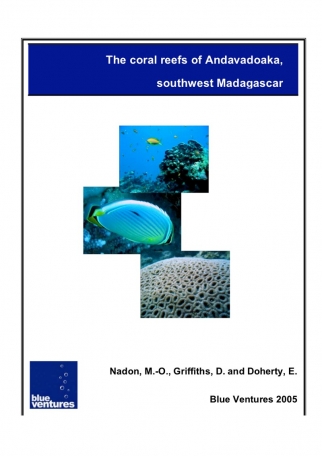Summary
This report presents the findings of the first in depth survey of the coral reefs of the Andavadoaka region, southwest Madagascar. Three reef systems (fringing, barrier and patch reefs) were surveyed between September 2004 and June 2005 for substrate composition, key invertebrate densities (e.g. sea urchins) and fish assemblages.
The coral reefs in the region are in generally pristine shape, ranging from moderate to excellent. Patch reefs had the highest coral cover and highest density of coral recruits (~45% and 35 recruits per 20 m2), followed by barrier reefs (~12% and 25 per 20 m2) and fringing reefs (~8% and 15 per 20 m2). Sea urchin assemblages varied greatly between reef systems, with fringing reefs being dominated by Echinothrix sp., barrier reefs by the rock-boring sea urchin Echinostrephus molaris and patch reefs by Diadema sp. On all reef types, algae grazing sea urchin densities were similar to levels encountered on protected reefs elsewhere in the western Indian Ocean and six times lower then on over fished reefs.
The density of certain rare or commercial invertebrates (giant clams, triton shells and sea cucumbers) did not differ significantly between the relatively unexploited patch reefs versus barrier and fringing reefs, which suggests that these are not yet over fished in the region.
Coral reef fish assemblages were significantly different on each reef system, with patch and barrier reefs being dominated by planktivores (e.g. fusiliers and sweepers) and fringing reefs being dominated by herbivores (e.g. damselfish). Reef fish densities were high on both patch and barrier reefs (~170 per 100 m2) compared to fringing reefs (~90 per 100 m2). This compares favourably with the lower densities found on both protected and unprotected reefs in Kenya and Tanzania (~80 per 100 m2). Patch and barrier reefs also had a higher reef fish diversity.
The coral reefs of the Andavadoaka region are not directly threatened by terrigenous sedimentation, as elsewhere in the country, due to the absence of major rivers. However, they are at risk from over fishing from a still small but rapidly increasing population of Vezo fishermen. Conservation efforts are currently underway to maintain the present status of these coral reefs, including the establishment of a marine protected area network encompassing parts of the barrier and patch reef systems.

















